9 Things to Do at Congaree National Park
This post may contain affiliate links.
Congaree National Park in South Carolina is a rich and diverse old-growth forest and floodplain where ancient hardwood trees grow alongside loblolly pines that reach heights never before seen.
Standing beneath the Congaree’s towering branches, you can watch the dark flood water sit still around the tree bases. Smell the damp moss, dark earth, and vibrant green leaves of the surrounding woods. The still water reflects the sky above and birds, insects, and wild boar call out in the quiet.
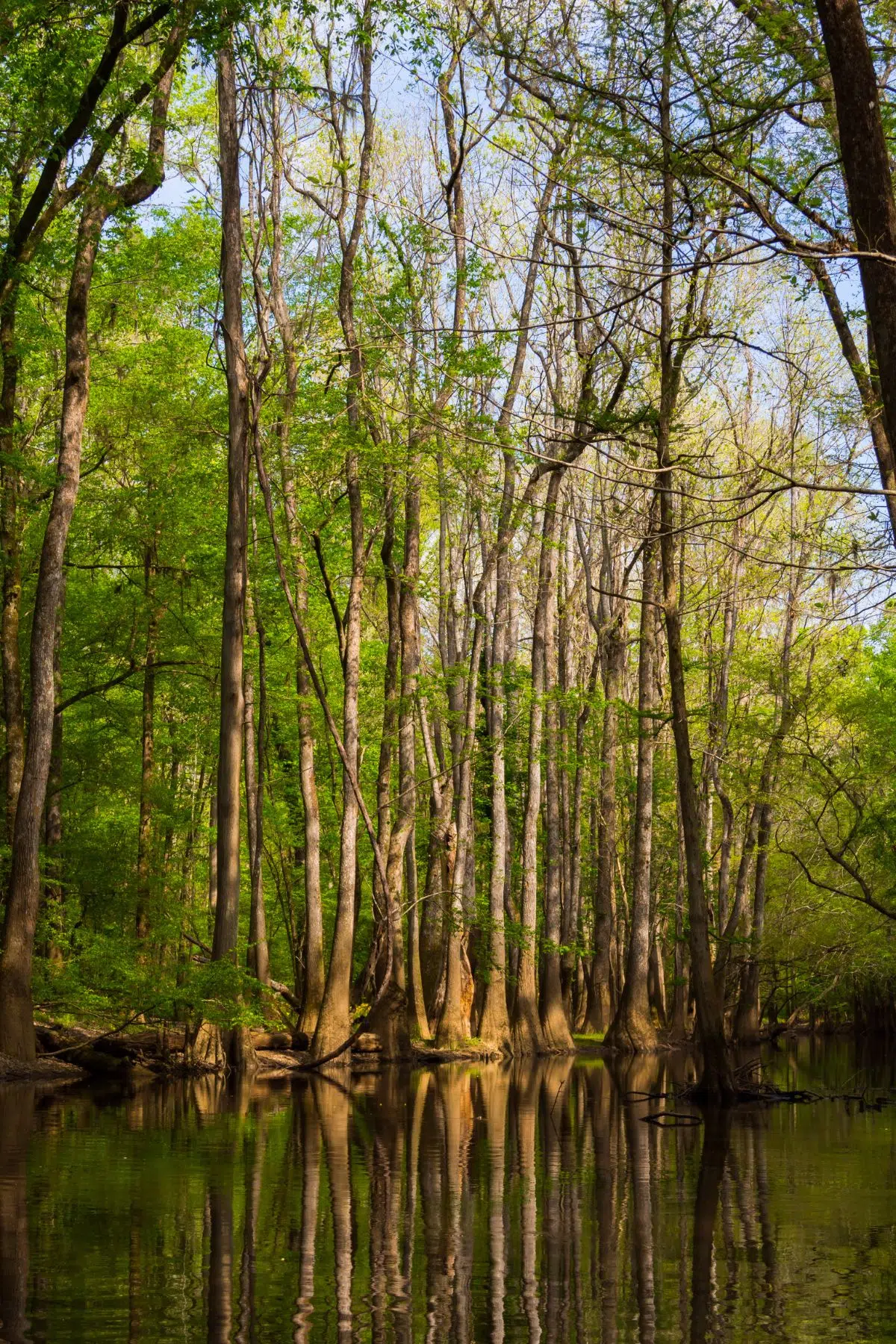
You are in a place teeming with life. Where generations of hands like yours have touched the bark of the ancient trees and minds like yours have reveled in its beauty.
In this guide, we will explore all the tips and recommendations we have for visiting South Carolina’s hidden gem: The Congaree National Park.
Congaree National Park History
Congaree was established as a national park as recently as 2003. Originally a timber source in the late 19th century, it became threatened by timber felling again in 1969. Harry Hampton, now a memorialized name within the park, began preservation efforts to protect the forest in the late 1960s, and in 1976 Congress established the Congaree as a National Monument.
The Biosphere of Congaree National Park
Congaree harbors 15 tree species’ tallest known specimens and is among the top forests known for their biodiversity in the United States.
Towering above all others in the Congaree is the tallest loblolly pine known to date. Measuring a whopping 167ft, it is one of the tallest trees on the United States East Coast. Others of this park’s champion species are a Sweetgum measuring 133ft, an American Elm hitting 135ft, and a Swamp Chestnut reaching 133ft.
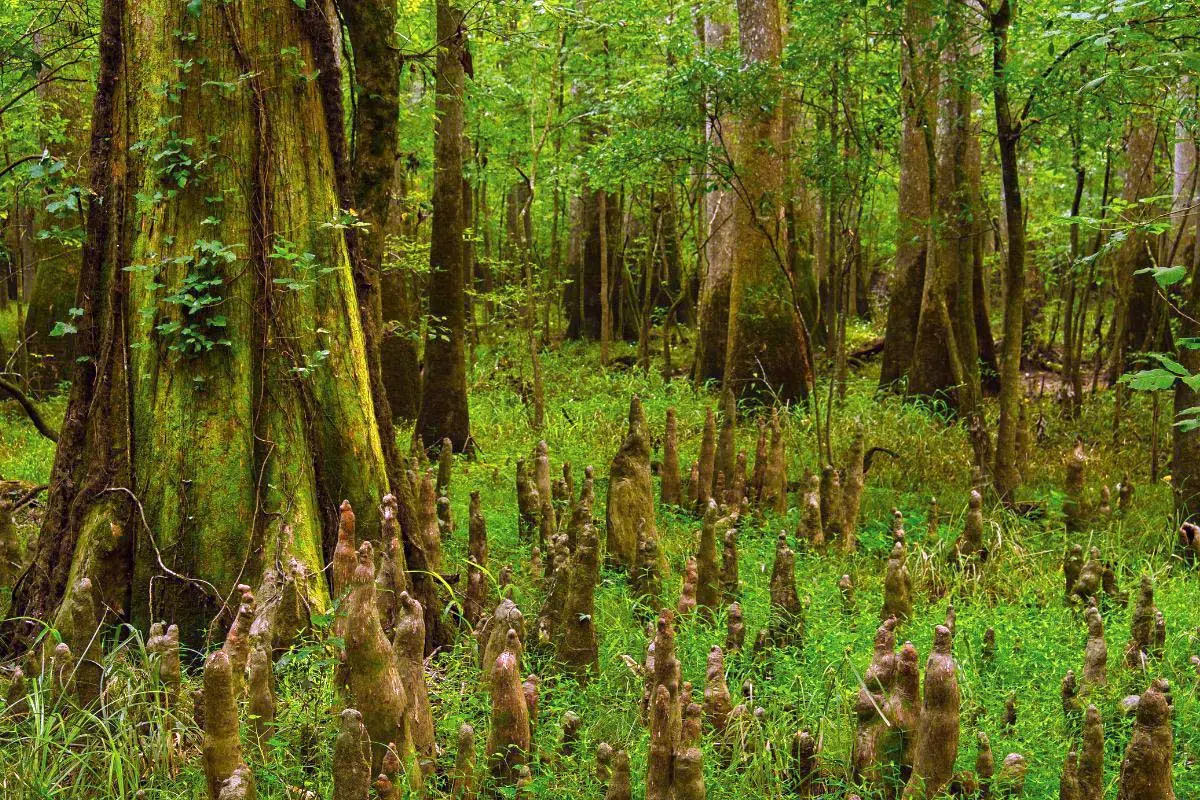
The forest’s oldest tree, a Bald Cypress called General Green Tree, is estimated to be around 1,000 years old. Perhaps one of the most famous and noteworthy features of the park are its Cypress trees. These strange trees produce ‘knees’ that form above the root system of the tree and can be seen rising above the floodwater. Though there are several speculations on why cypress trees have these knees, a definite answer is still unknown.
Among its incredibly diverse animal and plant life, Congaree is home to many state-listed endangered species, including the bald eagle, red-cockaded woodpecker, and swallow-tailed kite. Boars tromp through the undergrowth, river otters flit through its waters, and bobcats prowl hidden in the trees.
Top Things To Do At Congaree National Park

Hiking
Though the park offers few extensive single-trail options, the longest being 11mi, the park’s level paths and boardwalks make for easy walking and beautiful forest sights. Most of the trails intersect one another, so whether you are looking for an especially long hike or a short and easy walk, your options are open.
Boardwalk Loop Trail
The most popular and prettiest walk in the park. The boardwalk starts at the Visitors Center and loops through the bottomland and old-growth forest.
Trail Rating: Easy (2.6 miles round trip)
Bluff Trail
This trail starts at the visitors’ center and connects to the boardwalk for a time, then takes you through the upland’s new growth forest of loblolly pines.
Trail Rating: Easy (1.8 miles round trip)
Oakridge Trail
With a good view of some old oak trees, this path takes you through the old-growth forest and follows a slight ridge excellent for spotting wildlife. It is rated moderate because some portions of the path can be difficult to follow and may be obscured by fallen trees.
Trail Rating: Moderate (7.1 miles)
Weston Lake Loop Trail
This hike starts from the Boardwalk Loop Trail and goes through much of the old-growth forest, following Cedar Creek, before looping back and rejoining the boardwalk.
Trail Rating: Easy (4.5 miles round trip)
River Trail
This trail leads to the Congaree River. The path is simple and not as scenic as the boardwalk, but if you want a longer and level walk, this is a good one. Rated moderate only because some portions of the path may be less used and so difficult to follow
Trail Rating: Moderate (11.1 miles out and back)
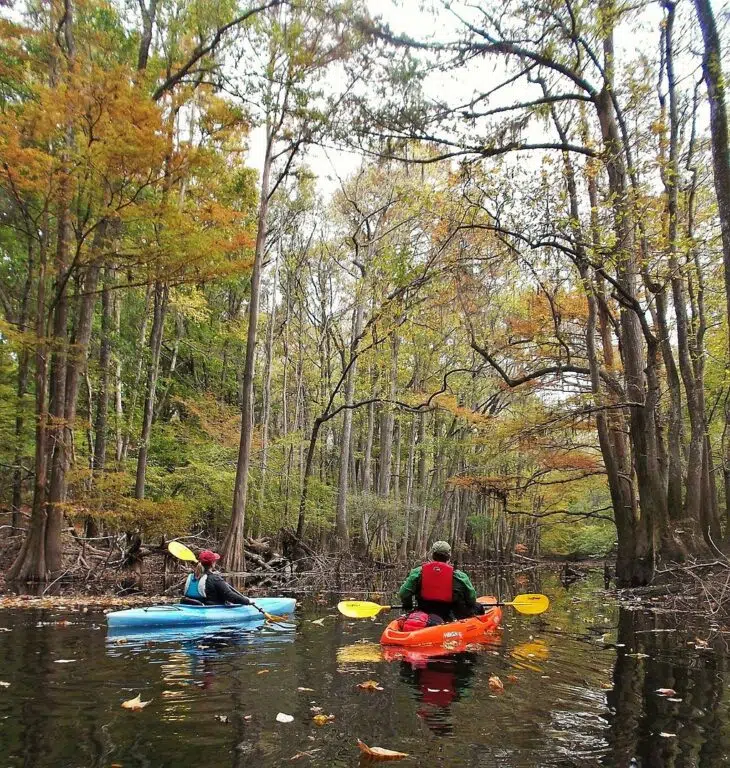
Canoeing and Kayaking
Experience the forest from a unique and close angle by exploring its waters on the Cedar Creek Canoe trail. With either a canoe or kayak, you can enter and exit at the Cedar Creek boat launch. Cedar Creek is slow-moving, so it is easy to paddle both upstream and downstream. Fallen trees sometimes block the way depending on the water level, so you may at times need to haul your boat overground to go around them. If you are by yourself, a kayak is probably your best option, as it makes for easier carrying. Check out Cedar Creek River conditions here.
Fishing
Looking for some relaxation and time to sit alone in thought? Fishing is permitted in the park and is a great way to enjoy its atmosphere. To fish, you must have a fishing license and follow the park’s guidelines found here.
Camping
If you are looking to camp, there are two camping places available in the park: the Longleaf Campground, near the park entrance road, and the Bluff Campground. Bluff Campground is around one mile from Longleaf and is accessible only on foot. Neither of these campsites has running water. Longleaf has two vault toilets, while Bluff has none.
To camp in the Congaree National Park, you must have a reservation to camp or have a backcountry permit. Congaree is rarely busy, so obtaining a camping spot is seldom an issue. More information on the park’s camping policies can be found here and reservations can be made here.
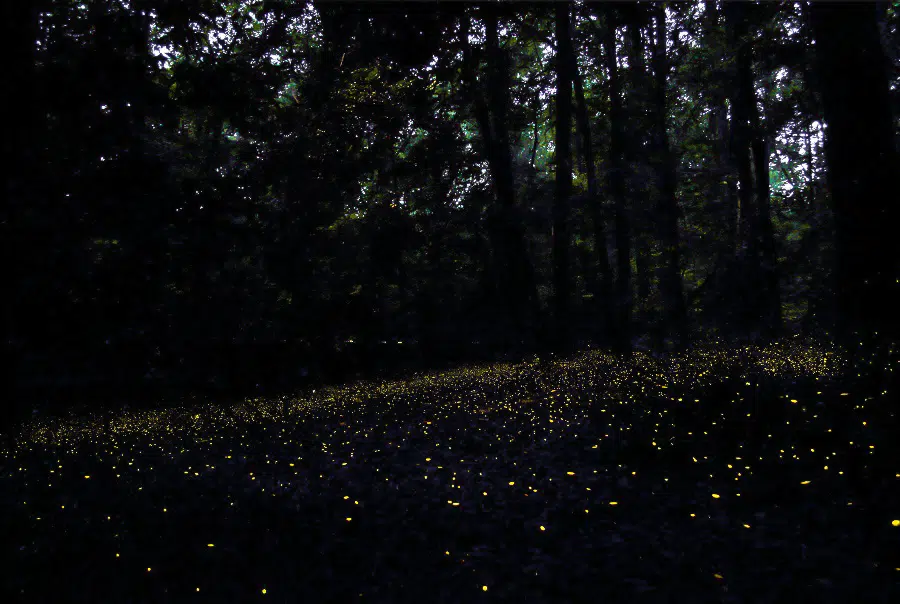
View The Fireflies
For two weeks every year, a rare occurrence happens in Congaree National Park. In a unique annual mating ritual, fireflies synchronize their flash patterns, creating a mesmerizing and awe-inspiring sight. Generally beginning around mid-May, this synchronization is best viewed between 9 pm-10 pm. This occurrence draws in thousands of people so, during the few weeks of the display, the park’s entrance times are limited. Lottery tickets for viewing the display are drawn to give equal opportunity to those who wish to see it. For more information on this event and its restrictions, look here.
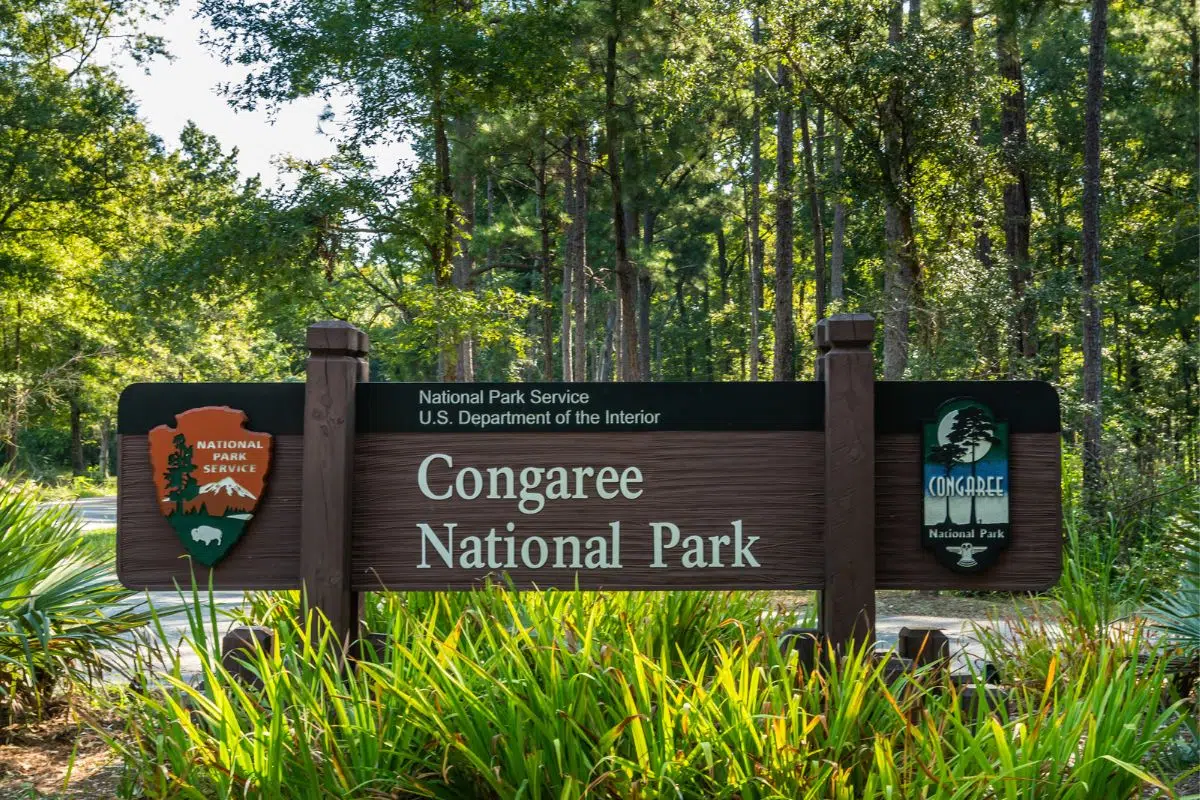
What Is The Best Time To Visit Congaree National Park?
The best time to visit the park is in the late fall and spring. Summer humidity and high temperatures can get oppressive in South Carolina, especially in the midlands. However, the mosquitoes are the deciding factor on when you should or should not visit. Because much of the park is a floodplain the mosquito population can become intense and vicious. Opting to visit in times with cooler weather or before the season’s mosquito frenzy has started, is recommended.
How Long to Visit Congaree National Park
The Congaree is a small park, so half a day is enough to either hike, fish, or canoe. Up to two days, with an overnight camp, is plenty of time to see what you want to see and do everything you want to do.
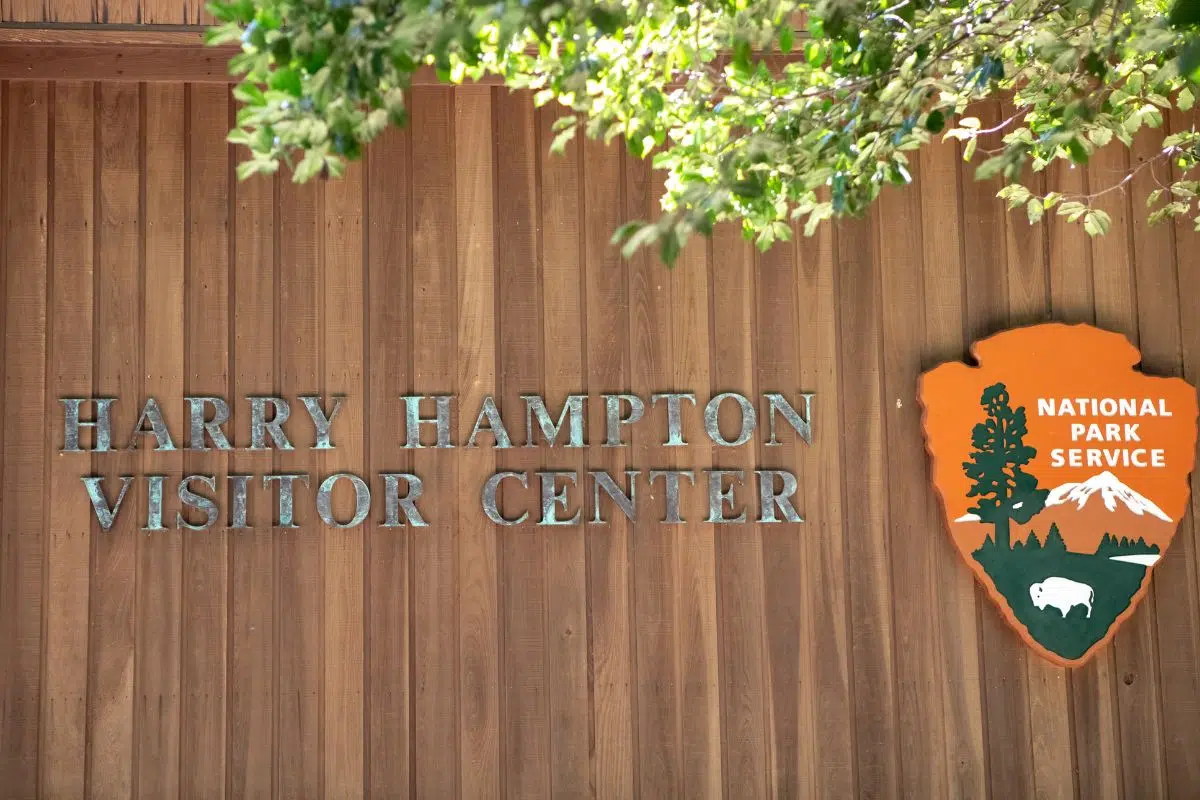
The Park Facilities
At the beginning of the boardwalk, and near the park’s entrance, is Congaree’s Harry Hampton Visitor Center. Though some portions of the center remain closed due to Covid-19, its restrooms, bookstore, and picnic grounds remain open. For updates on its closures and its hours, check here.
Need to Know Tips Before Visiting Congaree National Park
- Mosquitoes: even if you visit in the fall or spring, mosquitoes still may be present (check the 7 day mosquito forecast before your trip!). Bring bug spray no matter the time of year. You’d rather be safe than miserable.
- Flooding: occurs often in the Congaree and though it does not always cover the trails, water can cover even the boardwalk. Check here ahead of time to see the flood levels.
- Limited parking for oversized vehicles: even if there is campground space, there may not be space for your vehicle if it is too big. Call ahead to get details on parking spaces and availability for any oversized vehicles.
How To Get To Congaree National Park
The main entrance to the park is on Old Bluff Road. The gate remains open all night and all day and there are no entrance fees. From the gate, it is a two-minute drive either to the Visitors Center or to the Longleaf Campground Parking lot. The Cedar Creek entrance is a gravel parking lot right off the road. It is a back entrance and is not gated.
Driving Distances And Times To The Front Entrance
- From Columbia Metropolitan Airport: 23 mi (28 min)
- From Downtown Columbia: 17 mi (25 min)
- From Charleston, South Carolina: 106 mi (1 hr 51 min)
- From Charlotte, North Carolina: 93 mi (1 hr 37 min)
- From Atlanta, Georgia: 245 mi (3 hr 54 min)
Where To Eat In Columbia, South Carolina
Fancy Eats
- Bourbon: Whiskey bar and Cajun-Creole restaurant.
- Terra: Chef-driven neighborhood bistro focused on local produce.
- Motor Supply Company Bistro: Menu changes daily. A blend of contemporary American, French, Italian and Asian cuisine. Everything is either provided by local farms or is house-made.
Casual Eats
- Transmission Arcade: Clean and friendly arcade bar with high-tier bar food including smoked wings, banh mi fries, tika tacos, and smoked smash burgers.
- Hunter-Gatherer Brewery/Taproom: Various bar snacks and handcrafted pizzas with fantastic craft brews on tap.
- Tacos Nayarit: Unassuming and authentic, everything is made fresh right in front of you. From handmade tortillas to delicious tacos, gorditas, tortas, and more.
- Pho Viet Restaurant: Delicious flavorful and authentic Vietnamese cuisine with a simple calm atmosphere.
- Duke’s Pad Thai: Casual spot serving a mix of familiar and unique Thai noodle dishes and curries.
Other Outdoor Opportunities near Columbia, South Carolina
- Harbison State Forest: Hike and mountain bike in Columbia’s pine and hardwood state forest.
- Dreher Island State Park: Swim and hike on Columbia’s famous Lake Murray.
- Sesquicentennial State Park: Paddleboard on the lake, hike, and camp in the park’s green forest.
- Saluda Shoals: Rent a canoe or kayak, and swim in the Soluda’s year-round cool water.
- Cayce Riverwalk Park: Enjoy an easy walk or bike along the paved trail that follows the Congaree river. Rent a tube and take the bus up to the Saluda River to spend a few hours drifting slowly down Columbia’s lovely rivers.
Whether you are exploring the East Coast or are in Columbia for a few days, the Congaree National Park is a favorite among locals and a hidden gem within the nation.

